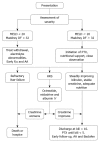Alcoholic hepatitis 2010: a clinician's guide to diagnosis and therapy
- PMID: 20954276
- PMCID: PMC2957598
- DOI: 10.3748/wjg.v16.i39.4905
Alcoholic hepatitis 2010: a clinician's guide to diagnosis and therapy
Abstract
Alcoholic hepatitis (AH) remains a common and life threatening cause of liver failure, especially when it is severe. Although the adjective "acute" is frequently used to describe this form of liver injury, it is usually subacute and has been developing for weeks to months before it becomes clinically apparent. Patients with this form of alcoholic liver disease usually have a history of drinking heavily for many years. While certain aspects of therapy, mainly nutritional support and abstinence are well established, significant debate has surrounded the pharmacologic treatment of AH, and many institutions practice widely varying treatment protocols. In recent years a significant amount of literature has helped focus on the details of treatment, and more data have accumulated regarding risks and benefits of pharmacologic treatment. In particular, the efficacy of pentoxifylline has become increasingly apparent, and when compared with the risks associated with prednisolone, has brought this drug to the forefront of therapy for severe AH. This review will focus on the clinical and laboratory diagnosis and pharmacologic therapies that should be applied during hospitalization and continued into outpatient management. We conclude that the routine use of glucocorticoids for severe AH poses significant risk with equivocal benefit, and that pentoxifylline is a better, safer and cheaper alternative. While the full details of nutritional support lie beyond the scope of this article, nutrition is a cornerstone of therapy and must be addressed in every patient diagnosed with AH. Finally, while traditional psychosocial techniques play a major role in post-hospitalization care of alcoholics, we hope to make the medical clinician realize his or her role in reducing recidivism rates with early and frequent outpatient visits and with the use of baclofen to reduce alcohol craving.
Figures

Comment in
-
Severe alcoholic hepatitis: glucocorticoid saves lives and transplantation is promising.World J Gastroenterol. 2011 May 21;17(19):2454. doi: 10.3748/wjg.v17.i19.2454. World J Gastroenterol. 2011. PMID: 21633648 Free PMC article.
References
-
- Jensen K, Gluud C. The Mallory body: morphological, clinical and experimental studies (Part 1 of a literature survey) Hepatology. 1994;20:1061–1077. - PubMed
-
- Becker U, Deis A, Sørensen TI, Grønbaek M, Borch-Johnsen K, Müller CF, Schnohr P, Jensen G. Prediction of risk of liver disease by alcohol intake, sex, and age: a prospective population study. Hepatology. 1996;23:1025–1029. - PubMed
-
- Naveau S, Giraud V, Borotto E, Aubert A, Capron F, Chaput JC. Excess weight risk factor for alcoholic liver disease. Hepatology. 1997;25:108–111. - PubMed
Publication types
MeSH terms
Substances
LinkOut - more resources
Full Text Sources
Medical

